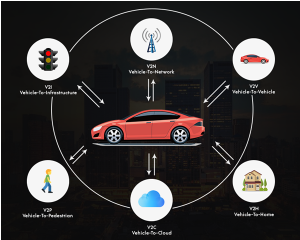Smart phones, smart applications; now what’s next taking in the smart form? It’s the emergence of smart cities. With evolving technological framework in businesses, industries, lifestyle bringing about advent in intelligent connectivity, the concept of smart cities is gaining huge ground in present times.
Self-Driving Vehicles – The Growth of Mobility in the Age of Smart Cities
Mobility is evolving rapidly around the world. Intelligent networks and technology is going to enable how transportation will be managed and improved with added flexibility and security. A smart city means each aspect of the way of life, from how they go about doing their business, to market procedure, to communication to how they move around on roads needs to be smart with smooth transition process, improved security and better connectivity between mobile factors.
Self-driving cars are being welcomed by all, but this concept comes with an apprehension about how they are going to become discernible and decision-making like a real human being. But with smart roads accompanying the self-driving cars equipped with enhanced technology and networking infrastructure means the two-way communication between vehicles and road infrastructure will pave way for helping the municipalities and authorities manage and improve the transportation, reduce congestion, decrease security risks on road.
For self-driving cars to become a successful in the long run, it will mean the introduction and development of a new infrastructure model, where-in roads connected with communication systems for interacting with vehicles will mean these vehicles will be able to get operated upon with ease.
Impact of Innovations like V2I, V2X and V2V Impacting Self-Driving Cars in Smart Cities
Adaptations to innovations like V2I (Vehicle-to-Infrastructure), V2V (Vehicle-to-Vehicle) and V2X (Vehicle-to-Everything) will mean creating an environment, or enabling the smart city environment, to provide heightened automation to road infrastructure and vehicles to communicate, exchange information, predict road behaviour in advance, and overcome the barriers that traditional human-based road movement haven’t been able to achieve.
We all have the notion that self-driving cars will enhance people’s movements along, reducing traffic congestions and accidental risks; but how does this going to take place?
This can only be achieved when the automated features of the self-driving cars are enhanced to become smart by making the entire surrounding of the self-driving cars intelligent, enabling a connected network of mobile vehicles and infrastructure that talk and create a smooth movement system. This interconnected system of network will leverage real-time data that will take informed, better decisions, anticipate problems and sync the functioning of the roads and the vehicles accordingly.
Connecting Vehicles to the Surroundings
Vehicle-to-Infrastructure (V2I) – One of the most important connected system of network will include vehicle-to-infrastructure, meaning a system of communication between vehicles and road infrastructure through an ad-hoc network. Road systems gather information from elements like streetlights, cameras, lane markers, parking meters, signage and RFID readers and transmit those to the vehicles.
Vehicle-to-Vehicle (V2V) – A system of communication channel done wirelessly between different vehicles on the road, to share information about their speed, direction, location and so. Vehicles are equipped with a 36o-degree view of other vehicles that enables these to predict any vulnerability early on.
Vehicle-to-Pedestrian (V2P) – This network system ensures vehicles are alerted about pedestrian proximity, and vice versa, along with helping collision chances and gain information about people nearby the vehicle. The pedestrian signal system also helps sight-disabled pedestrians inform vehicles and drivers about their presence.
Vehicle-to-X (V2X) – Vehicle-to-Everything, this system is an amalgamation of all the all the above mentioned networks and forms one manageable platform that helps vehicle communicate with their surroundings thoroughly, enabling better flow of vehicles, pedestrians, vehicle parking, and much more.
Smart City Technologies – Enabling Connected Vehicles and Infrastructure
Smart cities are powered by technologies of today and tomorrow, including Mobility as a Service (MaaS), Internet of Things (IoT), Big Data systems. Innovative implementations like V2I, V2V and V2X makes self-driving cars fully equipped with smart technological features coherent to a smart city platform. A connected vehicle means one that talks to other cars, technology equipped road infrastructure systems like traffic management systems, road sensors and other networks.
The combination of technologies forming the base of a smart city network which will create a system that will be the eyes of the vehicles on road means intelligent and integrated self-driving cars that know about the surrounding and act accordingly.
Information and communication technology give cities the platform to become smart, and enable a series of integrated network of sensors, devices, applications and services that are integral to planning and maintaining road transport with enhanced vehicle technological interfaces.


